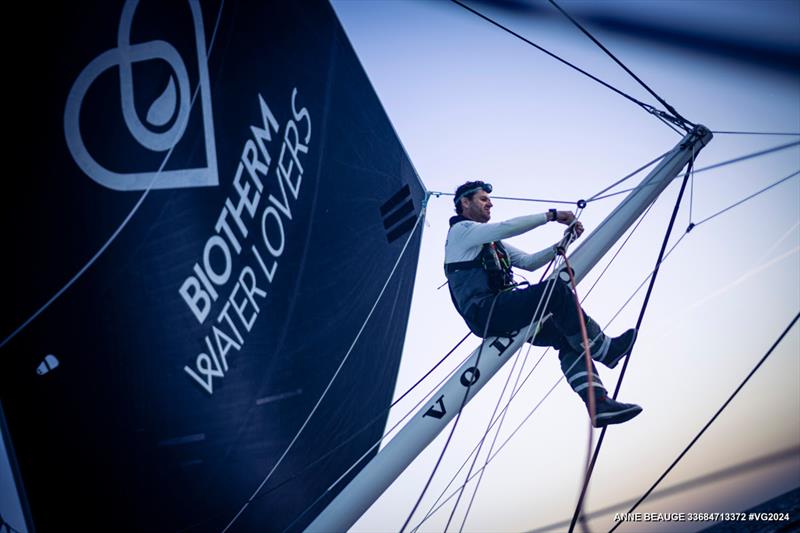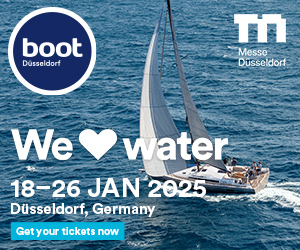
Update on the Vendée Globe Race: “The outcome of this low pressure system will hinge on just a few miles”
by Vendée Globe media, 24 Nov 09:23 PST
24 November 2024

Anthony Marchand on Biotherm © Anne Beauge


Anthony Marchand, the French skipper of Actual Ultim 3, who completed his first solo circumnavigation last winter during the Arkéa Ultim Challenge and participated in The Ocean Race 2023 on the IMOCA Biotherm alongside Paul Meilhat, Sam Davies, and Damien Seguin, shares his insights on the current conditions in the South Atlantic and this tenth edition of the Vendée Globe.
On this Sunday, the Vendée Globe leaders are encountering a secondary depression north of Rio de Janeiro and are beginning to sail downwind toward the Cape of Good Hope. It’s quite an unusual circumstance—one might even call it exceptional.
This minor depression, arriving at just the right moment, isn’t particularly severe, but it will create a nice downwind effect. The leaders will take highly direct courses. It’s a rarity to navigate such tight angles at this point in the globe. One could say it’s an almost flawless onset of the Southern Hemisphere for the leaders, at least.
How many of them do you think will capitalize on this depression and maintain their positions?
The top ten or twelve will likely get on board, but not everyone will be able to hold on to it for an extended time. Charlie Dalin (MACIF Santé Prévoyance) and Thomas Ruyant (VULNERABLE) may end up being the only ones to ride it all the way to the Cape of Good Hope. Ultimately, it will come down to just a few miles.
Should we anticipate the already divided fleet splitting into three groups?
Yes, but it’s not overly concerning because those who miss the depression will catch winds ahead of another significant system. They will lag behind those who rush ahead with the first but will still have favorable conditions for fast sailing. The group mostly comprising foiling boats will inevitably take longer, yet they will still enjoy a relatively direct course towards South Africa. In short, the South Atlantic crossing should unfold under good conditions, although the gaps will indeed tighten.
Can we expect speed records to be challenged again, particularly the 24-hour solo record and monohull record recently broken by Nicolas Lunven (Holcim – PRB) followed by Yoann Richomme (PAPREC ARKEA)?
Absolutely, it’s quite possible that several boats will break the record one after the other. In such scenarios, a few lateral miles can result in drastically different sea and wind conditions, leading to varying outcomes for each team based on their positioning relative to the depression. Those closest to the center will face bumpier rides compared to boats situated 200 miles further north. Furthermore, there are hull design differences to consider. The performance and comfort onboard will differ between boats like Thomas Ruyant’s or Yoann Richomme’s and Sam Goodchild’s (VULNERABLE), which can reach high speeds but tend to dig in at the bow.
Is it reasonable to predict one or two significant gaps will develop between the leaders and the tail enders by the time they reach the Cape of Good Hope?
It’s certainly feasible that there could be a 2,000-mile gap between the foiling leaders and the majority of the boats with daggerboards after eight days. However, nothing is certain. The standings could shift dramatically, just like they did in the last edition. In a round-the-world race, the elastic regularly stretches and contracts, and we’ve seen that play out in recent days.
You participated in The Ocean Race aboard Biotherm with Paul Meilhat, Sam Davies, and Damien Seguin last year. What are your thoughts on their performance up to now?
It’s fantastic to see them competing. They are actively in the race and appear to have their boats in good shape. However, they haven’t faced any significant fronts or tough conditions since the start, which is unusual for a Vendée Globe, where the fleet is still almost fully intact after two weeks at sea. We’ll see how things unfold from here. Soon enough, they will be entering the Big South where challenges are bound to arise. If any competitor needs to retire for any reason, getting to the coast for repairs or shelter could become quite complicated. Take Loïck Peyron’s case in 2008, for instance; he took three weeks to return to Australia after dismasting 650 miles from the Kerguelen archipelago. Problems in these areas can escalate quickly, and sometimes, it’s better to suffer breakdowns earlier in the race.
Find out more…


